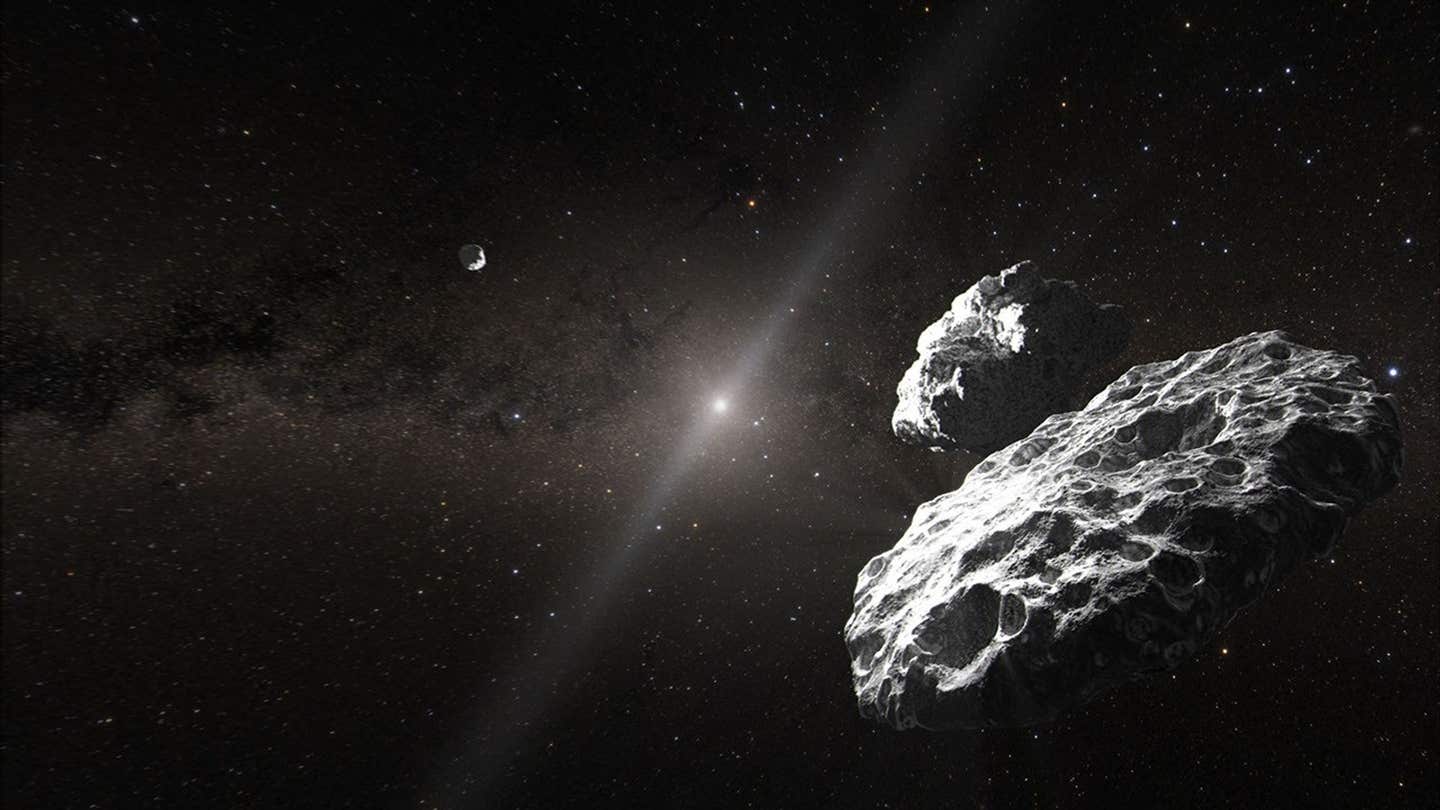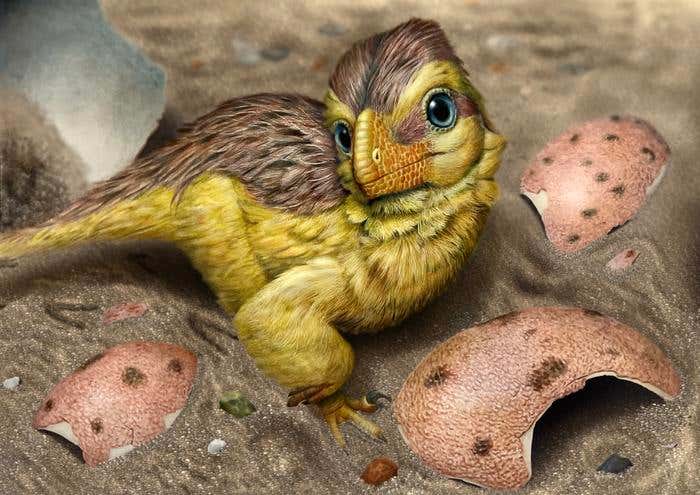Hubble telescope spots rare triple system hidden in the Kuiper Belt
Astronomers discover Altjira, a rare triple system in the Kuiper Belt, using Hubble and Keck data to reshape our view of solar history.

This artist’s concept depicts one of the possible scenarios for the 148780 Altjira system in the solar system’s Kuiper Belt. (CREDIT: John Olmsted)
The mystery of how planets and icy objects formed in the farthest reaches of our solar system just took an exciting turn. A team of researchers from NASA recently uncovered strong evidence for a rare and complex system of three icy space rocks orbiting one another in the Kuiper Belt. This remote region lies beyond Neptune and holds the frozen leftovers of the early solar system.
The object at the center of this discovery is called (148780) Altjira. Using advanced analysis and precise imaging from space and Earth, scientists found that Altjira is likely a hierarchical triple system. That means it consists of three separate bodies: two closely orbiting objects with a third circling them from farther away. This rare setup had only been found once before in this distant region of space.
What Is a Hierarchical Triple?
Most icy bodies beyond Neptune, called trans-Neptunian objects (TNOs), come in pairs. Two objects orbit one another, and we call them binaries. But Altjira appears to be something much rarer—a triple system. Researchers say that instead of two icy bodies locked together, Altjira includes three. Two orbit tightly at the center, while a third body travels in a wider path around them.
This system works like a cosmic dance, where each object moves in a delicate balance of gravitational pulls. These kinds of systems are hard to find and even harder to study. But they can reveal a lot about how the solar system formed.
Altjira now stands as the second known triple system of this kind in the Kuiper Belt. The first, called (47171) Lempo, also has three similar-mass bodies. That discovery shocked scientists. Until then, models only predicted a few such systems should exist, yet they now appear to be more common than once thought.
The Tools Behind the Discovery
Finding a triple system so far away is no easy task. Scientists relied on years of data and some of the most powerful telescopes in the world. They used the Hubble Space Telescope and the W. M. Keck Observatory in Hawaii to capture and study Altjira. Two new Hubble observations added to a dataset that spans an impressive 17 years.
To pull all the pieces together, researchers used a new open-source software tool called nPSF. It works by analyzing how light spreads in telescope images, allowing scientists to precisely measure the positions and movements of space objects. This helped confirm unusual motion in Altjira’s components.
Related Stories
Altjira lies about 3.7 billion miles from Earth. That's roughly 44 times the distance from the Earth to the Sun. At that range, it's tough to tell if one dot in a photo is really one object or two that are so close together they appear as one. But by closely tracking how the outer body’s orbit changes over time, the scientists found something strange.
“Over time, we saw the orientation of the outer object's orbit change,” said Darin Ragozzine, one of the study’s authors. “That indicated the inner object was either very elongated or actually two separate objects.”
This orbital shift pointed to a gravitational tug from an unseen mass—likely a third object. Lead researcher Maia Nelsen explained that imaging alone could not spot the hidden companion. “With objects this small and far away, the separation between the two inner members of the system is a fraction of a pixel on Hubble’s camera,” she said. “So you have to use non-imaging methods to discover that it's a triple.”
The research team’s model showed that a triple system provided the best match for the data. It fit better than other possibilities, such as an oddly shaped single object or two touching bodies forming a “contact binary.”
A Glimpse into the Past
This discovery doesn’t just reveal the makeup of one strange object. It could change what we know about how the entire Kuiper Belt—and even the solar system—formed.
Scientists believe that Kuiper Belt objects (KBOs) are primitive and icy remnants from the early days of the solar system, about 4.5 billion years ago. They formed from leftover material after the Sun and planets took shape. There are over 3,000 known KBOs, and many more may still be out there. Some may be over 10 miles wide.
Most small bodies in the Kuiper Belt form in pairs. Scientists used to think this happened through random collisions. But Altjira supports a different theory. According to this idea, triple systems like Altjira didn’t come from collisions but instead formed during a gravitational collapse. This happens when clumps of gas and dust in space come together and collapse under their own gravity, forming solid objects in place. It's how many stars are born, and this research suggests icy objects may have formed in a similar way.
“The universe is filled with a range of three-body systems,” said Nelsen. “That includes the closest stars to Earth, the Alpha Centauri star system, and we’re finding that the Kuiper Belt may be no exception.”
If more triple systems like Altjira are found, it would support this theory and reshape our view of the solar system’s history. So far, about 40 binary systems have been identified in the Kuiper Belt. With two triple systems now strongly suspected, scientists believe there could be many more waiting to be discovered.
A Cousin of Arrokoth
The Altjira system is part of the same family of KBOs as another object named Arrokoth. NASA’s New Horizons spacecraft visited Arrokoth in 2019, revealing its peanut-like shape. That shape told scientists Arrokoth is a contact binary—two bodies that touched and merged. Ragozzine calls Altjira a “cousin” of Arrokoth but notes that it’s about 10 times larger, measuring around 124 miles (200 kilometers) across.
While there’s no current mission planned to fly past Altjira, new opportunities for research are already here. The system has entered a rare event called an eclipsing season. During this time, the outer body passes in front of the central pair. This alignment will happen off and on until around 2030, giving astronomers many chances to collect more data.
“Altjira has entered an eclipsing season,” Nelsen said. “This will last for the next ten years, giving scientists a great opportunity to learn more about it.”
NASA’s powerful James Webb Space Telescope will also take a closer look at Altjira. During its upcoming observation cycle, Webb will check whether all three components reflect light the same way. That could offer more clues about their shapes and compositions.
What Comes Next?
Studying Altjira’s movement means going beyond the traditional way of thinking. Most orbital models treat distant objects like point masses and use simple equations known as Keplerian motion. But Altjira doesn’t behave that way. Instead, it follows a more complex, non-Keplerian path that hints at the inner structure of the system.
Using this method, researchers detected a gravitational signal—called a J2 term—that suggested the inner body wasn’t round. That distortion could best be explained by an unresolved inner binary, confirming the triple setup. With this model, scientists could build a better ephemeris—a tool to predict Altjira’s motion and mutual events like eclipses. This new model now provides much better predictions than the old Keplerian version.
This discovery reflects how advances in tools and time can help scientists understand objects that once seemed unreachable. It also shows that the Kuiper Belt may be hiding more surprises. With better telescopes and long-term data collection, researchers can continue revealing the stories locked in these ancient icy worlds.
The study on Altjira appears in The Planetary Science Journal. It highlights how long-term observation, detailed modeling, and powerful telescopes like Hubble continue to deepen our understanding of the solar system’s distant frontier.
Note: The article above provided above by The Brighter Side of News.
Like these kind of feel good stories? Get The Brighter Side of News' newsletter.



